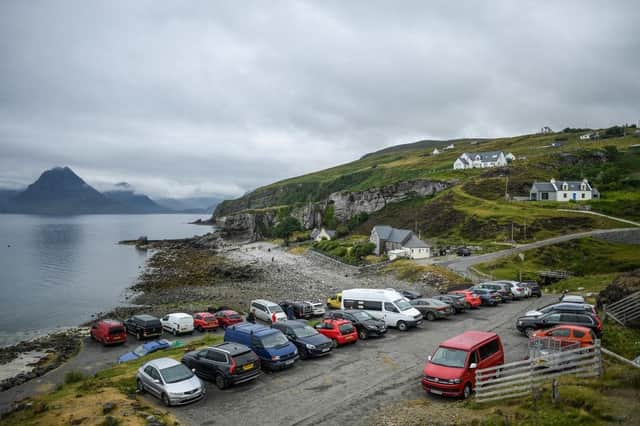Infrastructure lagging behind tourism


A good three decades ago, when I lived on the Isle of Skye, I was taken slightly aback to encounter two Chinese travellers ineptly dodging the surging surf as they came down the ramp off the Kyle-Kyleakin ferry.
Asiatic tourists were rare and noticeable then. My ferry companion’s observation that these adventurers were the beginning of something big stuck with me.
Advertisement
Hide AdAdvertisement
Hide AdHe was referring to the potential economic growth of China in the 21st century, a prediction which was accurate, but not the Silk Road tourism which accompanied it.
The exchange came back to me this month when I caught up with a Sgiathanach abroad (well, in Harris actually) and asked after his native island?
He replied that in Portree they were granted two weeks of grace after New Year before the first Chinese travellers appeared
This year the Isle of Skye expects one million tourists, a staggering figure when you consider the size of the island and that the permanent population is just under 13,000. For comparison, Bali, the Indonesian “paradise” and global destination had about eight million tourists in 2022.
Advertisement
Hide AdAdvertisement
Hide AdSince Niall Iain MacDonald belatedly discovered Raasay and publicised it on Gaelic radio, my personal paradise and escape from the constant hum of Skye has been compromised. I suppose it shouldn’t really be a secret that the highlight of a visit to busy Skye can be the ferry from Sconser.
However, one million visitors come with certain bonuses. Tourism generated £211 million for Skye in the months before lockdown and supported thousands of jobs, according to a year-long study.
Incidentally, Portree friends have fond memories of lockdown when they could walk down through the village and have time for a socially-distanced blether. It was Skye like it used to be, they told me. From vignettes like these you get the feeling that a lot has been lost in the gold rush.
There are also well documented disadvantages of having one million instagram snaps of the Old Man of Storr, from overcrowded roads, fraying infrastructure, pressure on the environment, lack of affordable housing to the cheese grater effect on the lives of those inhabitants who do not have a stake in the sector.
Advertisement
Hide AdAdvertisement
Hide AdI used to think the Western Isles had a decade advantage over Skye to prepare for the inevitable arrival of mass tourism. But the pandemic put paid to that. We are now on the steep upwards curve of tourism and paddling hard to stay ahead of the wave.
The last figures I can find for the Western Isles, or Outer Hebrides as we are marketed, was 217,000 visitors some seven years ago. Ferry disasters aside and cruise ship arrivals added you have to conclude the number is just growing.
Tourism is now the biggest private sector contributor to the islands economy, bringing in over £75 million a year and supporting over 1,000 jobs. Outer Hebrides Tourism has 400 paying members which must make it one of the best subscribed and representative business organisations in the Highlands and a voice to be listened to.
In terms of tourism provision we are terribly compromised. Services are cut to the bone and even ahead of the first cruise ship of the season the public toilet facilities in Stornoway were shut due to a lack of staff.
Advertisement
Hide AdAdvertisement
Hide AdAt island tourism hotspots, like the Carloway broch, the local community landlord is filling the gap with pay to use facilities. Community landowners, like Galson, are organising as gatekeepers, negotiating deals with cruise ship tours so that a cut stays in the local area, a tourist tax of kinds.
A Visitor Levy Bill, allowing councils to add a local tax to overnight accommodation, is winging through Holyrood. Opponents argue it will act as a disincentive to B&B providers, those which haven’t been sufficiently disincentivised by strangling regulation designed to cut Edinburgh’s overheated Air B&B market.
In Skye, Scotland’s biggest tourist destination bar Edinburgh, the sector is demanding any potential tourism tax stays on the island, rather than be absorbed by the distant Highland Council in Inverness.
Like Venice, there are calls for all visitors and vehicles, not just overnighters, to be charged entrance. That may sound severe until you look at the business model mass tourism like cruise lines use themselves. It all works on headage payments.
Advertisement
Hide AdAdvertisement
Hide AdSkye has had some support in dealing with overtourism. At the Fairy pools, a visitor hotspot where the roadside was simply swamped, an £800,000 investment created a huge carpark and an off-grid toilet bloc.
A shuttle bus service to the site may have been too radical but ideas like that have to be in the mix as the Western Isles make what has to be a swift adjustment to visitor numbers. Does every car have to go down a single track road to the Gearrannan blackhouses? Shouldn’t we ask instagrammers to at least consider making a contribution to maintaining the perfect backdrops they photograph?
With the figures going up, and another season upon us, we need to devise swift and effective ways of wrangling tourism, absorbing the numbers and ensuring the benefit of fleeting visits rubs off.